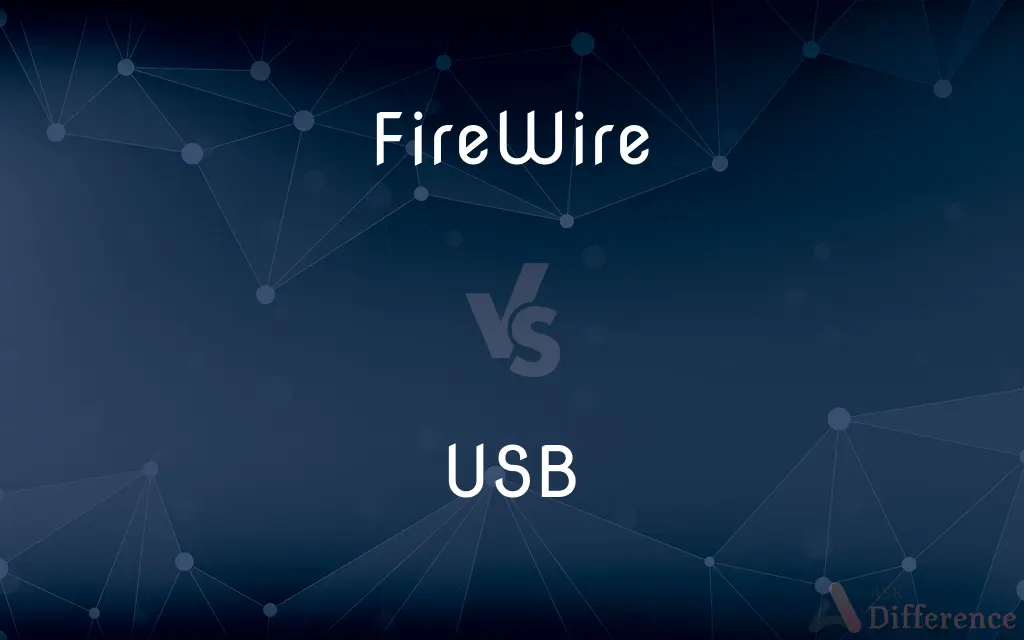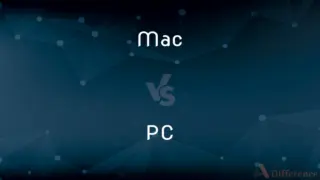FireWire vs. USB — What's the Difference?
By Tayyaba Rehman — Published on February 12, 2024
FireWire and USB are data transfer technologies. FireWire, developed by Apple, offers faster speeds and is used in professional audio/video equipment. USB, a universal standard, is widely adopted for diverse devices with varying speed capabilities.

Difference Between FireWire and USB
Table of Contents
ADVERTISEMENT
Key Differences
FireWire, developed by Apple in the 1990s, initially targeted high-speed data transfer for professional audio and video applications. It offered faster data transfer rates than contemporary USB standards, making it a preferred choice for professional equipment. USB, developed by a consortium, aimed at creating a universal standard for connecting diverse devices, initially focusing on simplicity and versatility.
FireWire, known for its daisy-chaining capability, allowed multiple devices to be connected in a series, simplifying cable management. USB, while offering similar capabilities, initially relied on a tiered-star topology. Over time, USB has evolved to support daisy-chaining through technologies like USB Type-C.
FireWire's adoption was prominent in professional audio and video equipment due to its stable data transfer rates and low latency. USB, being a universal standard, became the go-to choice for a wide array of consumer devices, including keyboards, mice, printers, and external storage.
The development and evolution of FireWire were closely tied to Apple products, limiting its prevalence in the broader market. USB, being a universal standard, gained widespread acceptance across various platforms and devices, becoming the primary connectivity option for most consumers.
Comparison Chart
Development
Developed by Apple
Developed by a consortium
ADVERTISEMENT
Data Transfer Speeds
Initially faster for professional use
Initially focused on simplicity, versatile
Topology
Daisy-chaining capability
Initially relied on tiered-star topology
Application Focus
Professional audio/video equipment
Universal connectivity for diverse devices
Market Adoption
Limited, closely tied to Apple products
Widespread, became a universal standard
Compare with Definitions
FireWire
Apple's Data Transfer: FireWire is Apple's high-speed data transfer technology.
Professional video editors often use FireWire for fast data transfer in their workflows.
USB
Universal Connectivity: USB offers universal connectivity.
USB has become the universal standard for connecting a wide range of devices, from smartphones to printers.
FireWire
Low Latency in AV: FireWire is known for low latency in professional audio/video applications.
Musicians prefer FireWire interfaces for recording due to their low latency and stable data transfer.
USB
Tiered-Star Topology: USB initially relied on a tiered-star topology.
Older USB configurations often involved a hub, creating a tiered-star network for connecting multiple devices.
FireWire
Daisy-Chaining: FireWire allows daisy-chaining of multiple devices.
With FireWire, you can connect your camera to your computer and your external hard drive in a daisy chain.
USB
Broad Platform Adoption: USB gained widespread acceptance across various platforms.
USB ports are standard on most computers, ensuring compatibility with a wide range of devices.
FireWire
Development by Apple: FireWire was developed by Apple in the 1990s.
The first generation of Apple's iPod used FireWire for fast data transfer.
USB
Consumer Device Connectivity: USB is widely used for consumer devices.
Keyboards, mice, and external hard drives commonly use USB for connecting to computers.
FireWire
Macintosh Connection: FireWire was closely associated with Macintosh computers.
FireWire ports were a common sight on older Macintosh computers for connecting external devices.
USB
Evolution to USB Type-C: USB has evolved to support daisy-chaining through USB Type-C.
The USB Type-C connector allows for versatile connectivity and even supports daisy-chaining for some devices.
FireWire
A high-speed digital link standard covered by the IEEE 1394-1995 standard.
USB
A serial bus standard used for transferring data to and from digital devices. USB devices such as mice and flash drives are often powered by their USB connection.
FireWire
A system of wires or tubes designed to detect fire and trigger automatic fire-extinguishers in an aircraft engine compartment for example.
Common Curiosities
What is a key feature of FireWire topology?
FireWire is known for its daisy-chaining capability, simplifying cable management.
Was FireWire closely tied to Apple products?
Yes, FireWire development and adoption were closely tied to Apple products.
When was FireWire developed?
FireWire was developed by Apple in the 1990s.
Why is FireWire used in professional audio/video equipment?
FireWire's stable data transfer rates and low latency make it popular in professional audio and video applications.
Who developed USB?
USB was developed by a consortium, aiming to create a universal standard for connectivity.
What is a notable feature of USB's evolution?
USB has evolved to support daisy-chaining through technologies like USB Type-C.
Which technology is considered a universal standard?
USB is considered a universal standard for connectivity across various platforms.
What was USB's initial focus?
USB's initial focus was on simplicity and versatility for connecting diverse devices.
What devices commonly use USB for connectivity?
USB is widely used for connecting devices like smartphones, printers, keyboards, and external hard drives.
What was FireWire initially designed for?
FireWire was initially designed for high-speed data transfer in professional audio and video applications.
What topology did USB initially rely on?
USB initially relied on a tiered-star topology.
Why did USB gain widespread acceptance?
USB gained widespread acceptance due to its universal compatibility and versatile connectivity options.
What limited the prevalence of FireWire?
FireWire's development and association with Apple products limited its prevalence in the broader market.
What is a common use of USB Type-C?
USB Type-C is used for versatile connectivity, supporting fast data transfer and even daisy-chaining for some devices.
Is USB commonly found on computers?
Yes, USB ports are standard on most computers, ensuring compatibility with a wide range of devices.
Share Your Discovery

Previous Comparison
Mac vs. PC
Next Comparison
60Hz Screen vs. 120Hz ScreenAuthor Spotlight
Written by
Tayyaba RehmanTayyaba Rehman is a distinguished writer, currently serving as a primary contributor to askdifference.com. As a researcher in semantics and etymology, Tayyaba's passion for the complexity of languages and their distinctions has found a perfect home on the platform. Tayyaba delves into the intricacies of language, distinguishing between commonly confused words and phrases, thereby providing clarity for readers worldwide.
















































